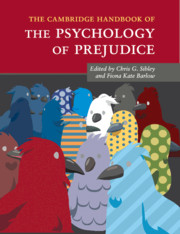Book contents
- Frontmatter
- Dedication
- Contents
- List of Figures
- List of Tables
- Notes on the Contributors
- Part I General Theoretical Perspectives
- 1 An Introduction to the Psychology of Prejudice
- 2 Evolutionary Approaches to Stereotyping and Prejudice
- 3 From Prejudice to Social Change: A Social Identity Perspective
- 4 Ingroup Projection as a Challenge of Diversity: Consensus about and Complexity of Superordinate Categories
- 5 Intergroup Discrimination: Ingroup Love or Outgroup Hate?
- 6 Intergroup Emotions Theory: Prejudice and Differentiated Emotional Reactions toward Outgroups
- 7 Intergroup Threats
- 8 Social Dominance Theory: Explorations in the Psychology of Oppression
- 9 The Dual Process Motivational Model of Ideology and Prejudice
- 10 Is Prejudice Heritable? Evidence from Twin Studies
- Part II Prejudice in Specific Domains
- Part III Prejudice Reduction and Analysis in Applied Contexts
- Index
- References
2 - Evolutionary Approaches to Stereotyping and Prejudice
from Part I - General Theoretical Perspectives
Published online by Cambridge University Press: 17 November 2016
- Frontmatter
- Dedication
- Contents
- List of Figures
- List of Tables
- Notes on the Contributors
- Part I General Theoretical Perspectives
- 1 An Introduction to the Psychology of Prejudice
- 2 Evolutionary Approaches to Stereotyping and Prejudice
- 3 From Prejudice to Social Change: A Social Identity Perspective
- 4 Ingroup Projection as a Challenge of Diversity: Consensus about and Complexity of Superordinate Categories
- 5 Intergroup Discrimination: Ingroup Love or Outgroup Hate?
- 6 Intergroup Emotions Theory: Prejudice and Differentiated Emotional Reactions toward Outgroups
- 7 Intergroup Threats
- 8 Social Dominance Theory: Explorations in the Psychology of Oppression
- 9 The Dual Process Motivational Model of Ideology and Prejudice
- 10 Is Prejudice Heritable? Evidence from Twin Studies
- Part II Prejudice in Specific Domains
- Part III Prejudice Reduction and Analysis in Applied Contexts
- Index
- References
Summary
Males are stereotyped as more competitive than females, females as more caring than men, and African Americans as more physically aggressive and violent than European and Asian Americans. Heterosexuals are prejudiced against homosexuals, locals are prejudiced against immigrants, and religious people are prejudiced against atheists. As generalizations, these statements are supported by considerable bodies of empirical work, many of which are reviewed in the other chapters of this handbook.
Werner Heisenberg, the theoretical physicist, noted that “what we observe is not nature itself, but nature exposed to our method of questioning” (1958/1999, p. 58). The findings just described characterize the nature of one small subset of stereotypes and prejudices and emerge from methods of questioning derived from a variety of theoretical perspectives – perspectives focusing, for example, on ingroup/outgroup distinctions, social identity and self-enhancement processes, and a need to justify discriminatory behaviors against others. As we will see throughout this chapter, however, the nature of stereotypes and prejudices is often more nuanced and complex than what the questioning favored by such approaches allows us to discern. These nuances have important implications not only for our understanding of stereotyping and prejudice but also for the theoretical frameworks aiming to explain them.
Some of these nuances exist in the form of more textured conceptions of stereotyping and prejudice, missed by traditional methodological lenses focused at levels insufficiently fine to detect them. For example, when researchers use traditional measures to assess prejudices against groups as varied as gay men and Mexican Americans, respondents report feeling similarly prejudiced and negative toward the two groups. When researchers ask respondents about their specific emotional reactions to these groups, however, respondents report feeling quite differently toward the groups – feeling disgust toward gay men but fear of Mexican Americans (Cottrell & Neuberg, 2005). Other complexities have been missed because they occur beyond the scope of the investigative lenses derived from traditional frameworks. Consider, for example, that stereotypes of young African American men being dangerous are especially likely to come to mind for perceivers who are physically in a dark environment (Schaller, Park, & Mueller, 2003), or that a woman's current ovulatory stage influences her prejudices against outgroup men (McDonald, Donnellan, Cesario, & Navarrete, 2015). As conceptual variables, environmental darkness and fertility status lie well outside the theoretical architectures of traditional theories.
- Type
- Chapter
- Information
- The Cambridge Handbook of the Psychology of Prejudice , pp. 21 - 46Publisher: Cambridge University PressPrint publication year: 2016
References
- 2
- Cited by



